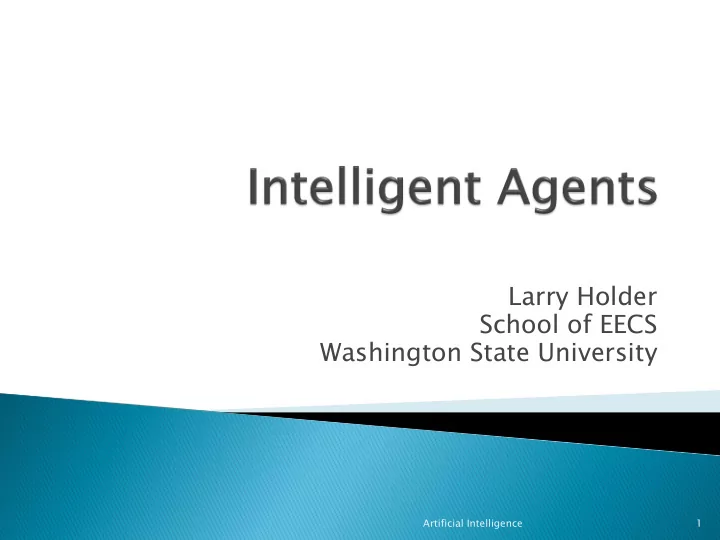

Larry Holder School of EECS Washington State University Artificial Intelligence 1
} What is an agent? } Rational agent } Types of environments } Types of agents Artificial Intelligence 2
} Agent perceives its environment through sensors and acts on its environment through actuators } Percepts: Perceptual inputs to the agent } Percept sequence: complete history of the agent’s percepts Artificial Intelligence 3
} Input: Percept = [location, state] ◦ Location ∈ {A, B} ◦ State ∈ {Clean, Dirty} } Return: Action ∈ {Left, Right, Suction} Vacuum World Vacuum Agent Action VacuumAgent (Percept p) { if (p = [?, Dirty]) then return Suction if (p = [A, Clean]) then return Right if (p = [B, Clean]) then return Left } Artificial Intelligence 4
} Rational Agent takes actions that maximize the performance measure given the percept sequence and any prior knowledge ◦ Performance measures? ◦ Prior knowledge? } Is VacuumAgent rational? Artificial Intelligence 5
CES 2019: www.youtube.com/watch?v=gfWjsKsEry0 Artificial Intelligence 6
} Should a rational agent: ◦ Know everything? ◦ Explore? ◦ Learn? Artificial Intelligence 7
} PEAS ◦ P erformance ◦ E nvironment ◦ A ctuators ◦ S ensors Ag Agen ent Type Performance Pe En Enviro ronment Ac Actuators rs Se Sensors Self-driving car Artificial Intelligence 8
Ag Agen ent Type Pe Performance Enviro En ronment Ac Actuators rs Sensors Se Puzzle solver Part picker Artificial Intelligence 9
} Fully observable vs. partially observable ◦ Do sensors give complete state of environment } Single agent vs. multiagent ◦ Are their other agents in the environment whose performance is affected by this agent } Puzzle solver? } Part picker? Artificial Intelligence 10
} Deterministic vs. stochastic ◦ Next state of environment completely determined by current state and agent’s action } Episodic vs. sequential ◦ Future percepts and actions do not depend on past percepts and actions } Puzzle solver? } Part picker? Artificial Intelligence 11
} Static vs. dynamic ◦ Can the environment change while the agent is deliberating } Discrete vs. continuous ◦ Are there a fixed number of environment states } Known vs. unknown ◦ Are the effects of actions known } Puzzle solver? } Part picker? Artificial Intelligence 12
} Hunt the Wumpus game ◦ Written in BASIC, 1972 ◦ First available on the TI-99/4A Artificial Intelligence 13
} Performance measure ◦ +1000 for leaving cave with gold ◦ -1000 for falling in pit or being eaten by wumpus ◦ -1 for each action taken ◦ -10 for using the arrow ◦ Game ends when agent dies or leaves cave Artificial Intelligence 14
} Environment ◦ 4x4 grid of rooms ◦ Agent starts in square [1,1] facing right with 1 arrow ◦ Location of wumpus and gold chosen at random other than [1,1] ◦ Each square other than [1,1] has a 0.2 probability of containing a pit Artificial Intelligence 15
} Actuators ◦ Forward ◦ TurnLeft by 90 ∘ ◦ TurnRight by 90 ∘ ◦ Grab picks up gold if agent in gold location ◦ Shoot shoots arrow in direction agent is facing Arrow continues until hits wumpus or wall ◦ Climb leaves cave if agent in [1,1] Artificial Intelligence 16
} Sensors (Boolean) ◦ Stench if wumpus in directly (not diagonally) adjacent square ◦ Breeze if pit in directly adjacent square ◦ Glitter if gold in agent’s current square ◦ Bump if agent walks into a wall ◦ Scream if wumpus is killed Artificial Intelligence 17
} Fully or partially observable? } Discrete or continuous? } Static or dynamic? } Deterministic or stochastic? } Single or multi-agent? } Episodic or sequential? } Known or unknown? Artificial Intelligence 18
} Details of design based on task (PEAS) and properties of environment Action Agent (Percept percept) { Process percept Choose action return action } Artificial Intelligence 19
} Table: Percepts à Actions } Where does table come from? } How large is table? Action TableDrivenAgent (Percept percept) { PerceptSequence percepts Table T Append percept to end of percepts action = Lookup (percepts, T) return action } Artificial Intelligence 20
} Where do rules come from? } Random component to avoid repetitive behavior Action SimpleReflexAgent (Percept percept) { RuleSet rules state = InterpretInput (percept) rule = RuleMatch (state, rules) action = rule.action return action } Artificial Intelligence 21
} Model describes how world evolves and effects of actions } Where do model and rules come from? } How to represent state and model? Action ModelBasedReflexAgent (Percept percept) { RuleSet rules Model model state = UpdateState (state, action, percept, model) rule = RuleMatch (state, rules) action = rule.action return action } Artificial Intelligence 22
} Search for sequence of actions to achieve goals } Model, state, goals ◦ Source? ◦ Representation? Artificial Intelligence 23
} Search for sequence of actions to reach a high utility state } Maximize expected utility } Model, state, utility ◦ Source? ◦ Representation? Artificial Intelligence 24
} Learning element changes agent to improve performance ◦ Models, rules, goals } Performance element one of previous agents } Critic provides feedback on agent’s performance } Problem generator drives agent to explore Artificial Intelligence 25
} Rational agent seeks to maximize performance } Agent’s task defined in terms of P erformance, E nvironment, A ctuators and S ensors } Agent’s environment defined in terms of multiple dimensions (observability, …) } Agent’s type defined in terms of reflexes, rules, models, goals and/or utilities } All agents can benefit from learning Artificial Intelligence 26
Recommend
More recommend